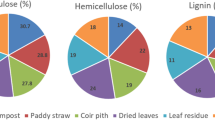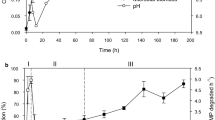Abstract
A microbial consortium consisting of three bacterial strains isolated from jute retting water with very high polygalacturonase (PG) (5.1–6.0 IU/ml), pectin lyase (PNL) (185.7–203.7 U/ml), xylanase (15–16.2 IU/ml) activity, but devoid of any cellulase activity was used for jute and mesta retting under controlled and farmers’ field conditions. The three isolates were identified as different strains of Bacillus pumilus, which were designated as PJRB1, PJRB2 and PJRB3 by ribotyping of a 977 bp fragment. The three strains, when used in a consortium mode, showed enhanced enzymatic activity and in a 1:2:1 ratio produced maximum activity of PG (21.7 IU/ml), PNL (238.0 U/ml), xylanase (15.8 IU/ml). Whole plant retting of jute and mesta with microbial consortium under controlled conditions reduced the retting duration by 7 days for jute, with improved fibre quality i.e. colour, lustre, fibre strength (27.0–28.1 g/tex, fineness (2.7–2.8 tex) and fibre recovery by 13.8–15.24 % over control.
Similar content being viewed by others
References
Ahamed A, Vermette P (2008) Enhanced enzyme production from mixed cultures of Trichoderma reesei RUT-C30 and Aspergillus Niger LMA grown as fed batch in a stirred tank bioreactor. Biochem Eng J 42:41–46
Ahmed M (2008) Studies on jute retting bacteria. J Appl Micribiol 26:117–126
Ahmed Z, Ahkter F (2001) Jute retting: an overview. Online J Biol Sci 7:685–688
Alam MDZ, Razi F, Aziz A, Molla AH (2003) Optimization of compatible mixed culture Trichoderma reesei and Aspergillus phoenicis on dairy manure. Proc Biochem 40:3087–3094
Alam MDZ, Razi F, Aziz A, Molla AH (2003) Optimization of compatible mixed cultures for liquid state bioconversion of municipal wastewater sludge. Water Air Soil Pollut 149:113–126
Bandopadhyay SB (1965) Assessment of jute fibre bundle strength. Jute Bull 27:1–8
Banik S, Basak MK, Paul D, Nayak P, Sardar D, Sil SC, Sanpui BC, Ghosh A (2003) Ribbon retting of jute—a prospective and eco-friendly method for improvement of fibre quality. Ind Crop Prod 17:183–190
Banik S, Basak MK, Sil SC (2007) Effect of inoculation of pectinolytic mixed bacterial culture on improvement of ribbon retting of jute and kenaf. J Nat Fibers 4:33–50
Bertheau Y, Madgidi-Hervan E, Kotoujansky A, Nguyen-The C, AndroT Coleno A (1984) Detection of depolymerase isoenzymes after electrophoresis, electrofocusing, or titration curves. Anal Biochem 139:383–389
Di Candilo M, Bonatti PM, Guidetti C, Focher B, Grippo C, Tamburini E, Mastromei G (2010) Effects of selected pectinolytic bacterial strains on water-retting of hemp and fibre properties. J Appl Microbiol 108(1):194–203
Castillo MR, Gutierrez- Correa M, Linden JC, Tengerdy RP (1994) Mixed culture solid substrate fermentation for cellulolytic enzyme production. Biotechnol Lett 16:967–972
Codner RC (2001) Pectinolytic and cellulolytic enzymes in the microbial modification of plant tissues. J Appl Bacteriol 84:147–160
Cotty PJ, Cleveland TE, Brown RL, Mellon JE (1990) Variation in polygalacturonase production among Aspergillus flavus isolates. Appl Environ Microbiol 56:3885–3887
Das B, Chakrabarti K, Ghosh S, Majumdar B, Tripathi S, Chakraborty A (2012) Effect of efficient pectinolytic bacterial isolates on retting and fibre quality of jute. Ind Crops Prod 36:415–419
Das B, Chakraborty A, Ghosh S, Chakrabarti K (2011) Studies on the effect of pH and carbon sources on enzyme activities of some pectinolytic bacteria isolated from jute retting water. Turk J Biol 35:671–678
Dhillon A, Gupta JK, Jauhari BM, Khanna S (2000) A cellulase–poor, thermostable, alkalitolerant xylanase produced by Bacillus circulans AB 16 grown on rice straw and its application in biobleaching of eucalyptus pulp. Bioresour Technol 73:273–277
Doi RH, Kosugi A (2004) Cellulosomes: plant-cell-wall-degrading enzyme complexes. Nat Rev Microbiol 2:541–551
Duarte MCT, Pellegrino ACA, Portugal EP, Ponezi AN, Franco TT (2000) Characterization of alkaline xylanases from Bacillus pumilus. Braz J Microbiol 31:90–94
Fang H, Zhao C, Song X, Chen M, Chang Z, Chu J (2013) Enhanced cellulolytic enzyme production by the synergism between Trichoderma reesei RUT-C-30 and Aspergillus niger NL02 and by the addition of surfactants. Biotechnol Bioprod Eng 18:390–398
Garcia- Kirchner O, Munoz-Aguilar M, Perez-Villalva R, Huitron-Vargas C (2002) Mixed submerged fermentation with two filamentous fungi for cellulolytic and xylanolytic enzymes production. Appl Biochem Biotechnol 98–100:1105–1114
Gomes I, Saha RK, Mohiuddin G, Hoq MM (1992) Isolation and characterization of a cellulose-free pectinolytic and hemicellulolytic thermophilic fungus. World J Microbiol Biotechnol 8:589–592
Guidelines for the Conduct of Test for Distinctivenss,Uniformity and Stability on jute (Corchorus olitorius L. and Chorchorus capsularis L.), 2008. Government of India, Registrar, on behalf of the Chairperson, PPV & FR Authority, New Delhi
Gutierrez- Correa M, Portal L, Moreno P, Tengerdy RP (1999) Mixed culture solid fermentation of Trichoderma reesei and Aspergillus niger on sugarcane baggasse. Bioresour Technol 68:173–178
Han SO, Cho HY, Yukawa H, Inui M, Doi RH (2004) Regulation and expression of cellulosomes and non- cellulosomal (hemi)cellulolytic enzymes in Clostridium cellulovorans during growth on different carbon sources. J Bacteriol 186:4218–4227
Haque MS, Ahmed Z, Asaduzzaman M, Quashem MA, Akhter F (2002) Distribution and activity of microbial population for jute retting and their impact on water of jute growing areas of Bangladesh. Pak J Biol Sci 5:704–706
Haque MS, Zakaria A, Adhir KB, Firoza A (2003) Identification of Micrococcus sp. responsible for the acceleration of jute retting. Pak J Biol Sci 6:686–687
Jayani RS, Saxena S, Gupta R (2005) Microbial pectinolytic enzymes: a review. Process Biochem 40:2931–2944
Jayani RS, Shukla SK, Gupta R (2010) Screening of bacterial strains for polygalacturonase activity: its production by Bacillus sphaericus (MTCC 7542). Enzyme Res. 2010(5)
Hu J, Arantesd V, Saddler JN (2011) The enhancement of enzymatic hydrolysis of lignocellulosic substrates by the addition of accessory enzymes such as xylanase: is it an additive or synergistic effect? Biotech Biofuels 4:36
Kashyap DR, Chandra S, Kaul A, Tewari R (2000) Production, purification and characterization of pectinase from a Bacillus sp.DT7. World J. Microbiol. Biotecnol 16:277–282
Kundu BC, Basak KC, Sarcar PB (1959) Physical character of jute fibre. Jute in India-A Monograph. The Indian Central Jute Committee, Calcutta, pp 337–350
Macrae A (2000) The use of 16S rDNA methods in soil microbial ecology. Braz J Microbiol 31:77–82
Mashihuzzaman M, Rahaman M, Mian AJ (1985) Structural studies of hemicelluloses from jute fiber and stick (Corchorus capsularis Linn). Bangladesh J Jute Res 10:7–13
Miller GL, Blum R, Glennon WE, Burton AL (1960) Measurement of carboxymethylcellulase activity. Anal Biochem 1:127–132
Miller GL (1959) Use of dinitrosalicylic acid reagent for determination of reducing sugar. Anal Chem 31(3):426–428
Monisha R, Uma MV, Krishna Murthy V (2009) Partial purification and characterization of Bacillus pumilus xylanase from soil source. Kat Univ J Sci Eng Technol 5(2):137–148
Nedjma M, Hoffmann N, Belarbi A (2001) Selective and sensitive detection of pectin lyase activity using a colorimetric test: application to the screening of microorganisms possessing pectin lyase activity. Anal Biochem 291:290–296
Phutela U, Dhuna V, Sandhu S, Chadha BS (2005) Pectinase and polygalacturonase production by a thermophilic Aspergillus fumigatus isolated from decomposting orange peels. Braz J Microbiol 36:63–69
Ramanujam PK, Saritha N, Subramanian P (2008) Production of pectin lyase by solid state fermentation of sugarcane bagasse using Aspergillus niger. Adv Biotech 6(12):30–33
Sakai T, Sakamoto T, Hallaert J, Vandamme EJ (1993) Pectin, pectinase and protopectinase: production, properties and applications. Adv Appl Microbiol 39:231–294
Sambrook J, Russel DW (2001) Molecular cloning: a laboratory manual. CSH Laboratory Press, New York
Wolfa S, Mouilleb G, Pellouxc J (2009) Homogalacturonan methyl-esterification and plant development. Molecul Plant 2(5):851–860
Soriano M, Diaz P, Pastor FIJ (2005) Pectinolytic systems of two aerobic sporogenous bacterial strains with high activity on pectin. Curr Microbiol 50:114–118
Thakur A, Pahwa R, Singh S, Gupta R (2010) Production, purification, and characterization of polygalacturonase from Mucor circinelloides ITCC 6025. Enzyme Research. Article ID 170549
Topp E, Zhu H, Nour SM, Houot S, Lewis M, Cuppels D (2000) Characterization of atrazine-degrading Pseudaminobacter sp. isolated from Canadian and French agricultural soils. Appl Environ Microbiol 66:2773–2782
van Buren JP (1991) Function of pectin in plant tissue structure and firmness. In: Walter RH (ed) The chemistry and technology of pectins. Academic press, Inc., New York, pp 4–10
Zhang J, Henriksson G, Johansson G (2000) Polygalacturonase is the key component in enzymatic retting of flax. J Biotechnol 81:85–89
Zheng L, Du Y, Zhang J (2001) Degumming of ramie fibres by alkalophilic bacteria and their polysaccharide- degrading enzymes. Bioresource Technol 78:89–94
Acknowledgments
The assistance from Ministry of Textiles, Govt. of India under Technology Mission on Jute through Indian Council of Agricultural Research via Central Research Institute for Jute & Allied Fibres (CRIJAF), is greatly acknowledged. The authors express their indebtedness to the Director, CRIJAF for providing laboratory and other necessary facilities.
Author information
Authors and Affiliations
Corresponding author
Rights and permissions
About this article
Cite this article
Das, S., Majumdar, B. & Saha, A.R. Biodegradation of Plant Pectin and Hemicelluloses with Three Novel Bacillus pumilus Strains and Their Combined Application for Quality Jute Fibre Production. Agric Res 4, 354–364 (2015). https://doi.org/10.1007/s40003-015-0188-0
Received:
Accepted:
Published:
Issue Date:
DOI: https://doi.org/10.1007/s40003-015-0188-0




